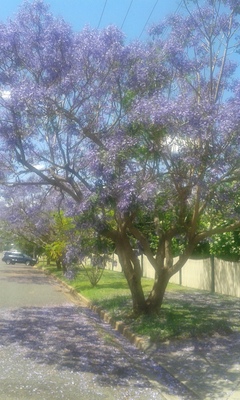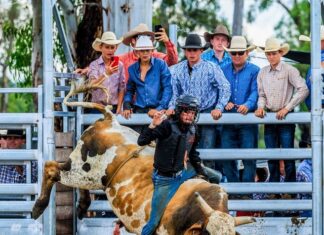THERE’S plenty of purple around our towns right now with jacaranda season in full bloom. Free Times gardening columnist BEATRICE HAWKINS shares her musings with us for the week.
JACARANDAS are out. Beautiful purple blossoms covering delicately arching branches.
Wherever I’ve lived there seems to have always been jacaranda trees.
Some of my earliest memories are of carpets of purple beneath trees that had dozens of rock orchids attached to their trunks in full flower.
Gorgeous big sprays of dainty white and cream to pale yellow orchids… the perfume was wonderful!
It was a ritual I welcomed each year in mid-November on the central coast of NSW until I was about 18 and shifted away.
There were more jacaranda trees in the next place I lived and in many other towns over the years. Sometimes they were as street trees and sometimes just in gardens but always spectacularly beautiful at this time of year.
I don’t think there is anything more beautiful than the undisturbed purple carpet under the trees first thing in the morning and then to be able to look up through the canopy on a clear blue day.
As street trees they look great and mixed with silky oaks and native frangipani they look spectacular, especially from the lookout in Tamworth.
Of course who could forget the avenues in Grafton and the Jacaranda Festival, the oldest family floral festival in Australia, having commenced in 1935 to lift the spirits and fortunes of a town still recovering from the Great Depression.
The first jacaranda tree planted in Australia was grown in the Brisbane Botanical Gardens in 1864 and remained there until 1979 when it was blown over in a cyclone.
Henry Volkers wasn’t far behind, introducing jacarandas to Grafton, planting 60 trees in 1879 and more the following year.
In 1910 a further 84 trees were sent from the Royal Botanical Gardens in Sydney and from then they became the principal street tree planted in Grafton.
Grafton also lays claim to the largest jacaranda tree in Australia being 25 metres tall and 5.5 metres in circumference, closely followed by a tree in Singleton claiming 35 metres height but only 3.5 metres circumference. Both impressive trees in anyone’s language!
Partnered with the red blossoms of the native Illawarra flame tree they also look wonderful. Both can be seen growing in the bush as you travel down the eastern side of Cunningham’s Gap.
Although they are native to Brazil they seem to be able to cope with a wide variety of climates in Australia. With some care when young I’ve even seen them become mature trees in areas that have huge frosts and snow.
Optimally they prefer an open sunny position in a well- drained, nutrient rich, sandy soil with protection from frosts when they are young and with mulching and deep watering in summer.
If you have the room they are a beautiful specimen tree in a lawn and there are many of them providing spectacular displays in Warwick at the moment.
I am looking forward to the Horticultural Society bus trip to Stanthorpe on Friday 18 November, especially to seeing Fay Helwig’s beautiful Flanders poppies field.
Hurry down to Danny Lyon’s store to claim a seat and join us at Crisps for departure at 8.30am, homemade morning tea at Dalveen and a fun filled day out visiting the various attractions and returning home about 5pm.
For information call Margot on 4661 1414.






